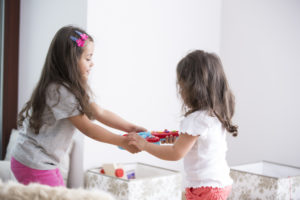
Siblings between the ages of 3 and 7 years old engage in some kind of conflict on average 3.5 times an hour according to Laurie Kramer, professor of applied family studies at the University of Illinois at Urbana-Champaign. That’s one squabble about every 17 minutes!
For the 2 to 4 year age group the average number of conflict situations rises to 6.3 times per hour, or about every 9 minutes.
No wonder as parents we have days where we feel that all the children do is fight!
What can we as parents do to help make life a little smoother?
Conflict is not necessarily a bad thing. How we are taught to handle conflict and come to win/win agreements is perhaps vital for a two-year-old. Children who have the best conflict resolution skills at home carry those abilities to school, the workplace and into later life. Siblings, also, may be our true partners in life, as we maintain relationships to the end of our lives.
Much of our younger children’s conflicts has to do with getting parents’ attention.
Our children want and need our love, time and attention. Even though we try to be fair, our children’s perspective can be very different from ours. You can give children identical t-shirts in different colors and you might hear—But she got the red one! And from the person who got the red shirt—But she got the blue one!
Situations like this t-shirt example are ones where we can step back and let our children sort it out. If they both really wanted the other color they’ll negotiate and trade without our interference. On the other hand, if the conflict is about getting our attention they’ll calm down and be happy with the gift, if we don’t enter the conflict and try to sort it out for them.
Most of the time we can and should step back and not get sucked up into the turmoil.
One of my strategies with my daughters was the “time-out.”
When bickering got to a boiling point I’d call a “time-out” using a football hand signal along with humorous body language, and we’d all go to the couch. I’d say something like, “Okay. Let’s take a deep breath. I am your mother you loves you more than anything else on this planet. You are sisters who love each other. Let’s think about that silently for two minutes before another word is said.”
I’d sit in the middle with an arm around each daughter, and usually the conflict calmed down to a manageable level, or perhaps forgotten altogether. A bit of humor and connection to love helped calm the waters.
It is perhaps wise to watch our young children in their negotiations.
The conflict may get physical, and our first response may be to jump up, separate kids and send them to their rooms. As long as the physical contact is not dangerous, stand back. Intervene as a last resort. Our two-year-olds with their physical contact are learning that their bodies can hurt each other, and usually after a scuffle or two they’ll begin to use words to negotiate upsets.
Learning to choose words will come from our conscious teaching of skills when there is no conflict occurring. Five-step problem solving is one of the key skills that we should teach our children.
Click here to read a Kids Talk article about five step problem solving.

